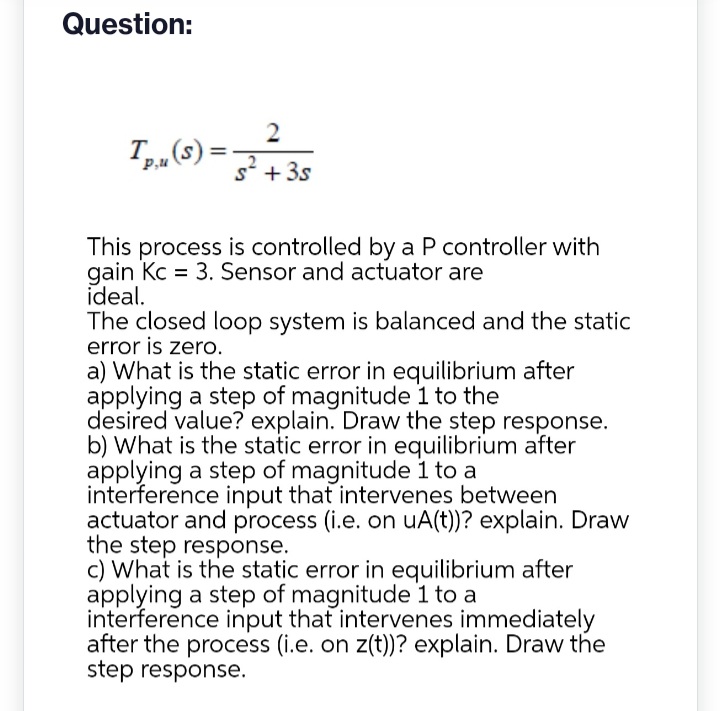Question: 2 Tp.u(s) T₁₂ (8) = 3²7 +35 This process is controlled by a P controller with gain Kc = 3. Sensor and actuator are ideal. The closed loop system is balanced and the static error is zero. a) What is the static error in equilibrium after applying a step of magnitude 1 to the desired value? explain. Draw the step response. b) What is the static error in equilibrium after applying a step of magnitude 1 to a interference input that intervenes between actuator and process (i.e. on uA(t))? explain. Draw the step response. c) What is the static error in equilibrium after applying a step of magnitude 1 to a interference input that intervenes immediately after the process (i.e. on z(t))? explain. Draw the step response.
Question: 2 Tp.u(s) T₁₂ (8) = 3²7 +35 This process is controlled by a P controller with gain Kc = 3. Sensor and actuator are ideal. The closed loop system is balanced and the static error is zero. a) What is the static error in equilibrium after applying a step of magnitude 1 to the desired value? explain. Draw the step response. b) What is the static error in equilibrium after applying a step of magnitude 1 to a interference input that intervenes between actuator and process (i.e. on uA(t))? explain. Draw the step response. c) What is the static error in equilibrium after applying a step of magnitude 1 to a interference input that intervenes immediately after the process (i.e. on z(t))? explain. Draw the step response.
Introductory Circuit Analysis (13th Edition)
13th Edition
ISBN:9780133923605
Author:Robert L. Boylestad
Publisher:Robert L. Boylestad
Chapter1: Introduction
Section: Chapter Questions
Problem 1P: Visit your local library (at school or home) and describe the extent to which it provides literature...
Related questions
Question
Please answer all the questions step wise in neat and clean handwriting.I will definitely upvote to you.

Transcribed Image Text:Question:
2
Tp. (S) = 32 +35
P,u
This process is controlled by a P controller with
gain Kc = 3. Sensor and actuator are
ideal.
The closed loop system is balanced and the static
error is zero.
a) What is the static error in equilibrium after
applying a step of magnitude 1 to the
desired value? explain. Draw the step response.
b) What is the static error in equilibrium after
applying a step of magnitude 1 to a
interference input that intervenes between
actuator and process (i.e. on uA(t))? explain. Draw
the step response.
c) What is the static error in equilibrium after
applying a step of magnitude 1 to a
interference input that intervenes immediately
after the process (i.e. on z(t))? explain. Draw the
step response.
Expert Solution
This question has been solved!
Explore an expertly crafted, step-by-step solution for a thorough understanding of key concepts.
Step by step
Solved in 8 steps with 7 images

Knowledge Booster
Learn more about
Need a deep-dive on the concept behind this application? Look no further. Learn more about this topic, electrical-engineering and related others by exploring similar questions and additional content below.Recommended textbooks for you

Introductory Circuit Analysis (13th Edition)
Electrical Engineering
ISBN:
9780133923605
Author:
Robert L. Boylestad
Publisher:
PEARSON

Delmar's Standard Textbook Of Electricity
Electrical Engineering
ISBN:
9781337900348
Author:
Stephen L. Herman
Publisher:
Cengage Learning

Programmable Logic Controllers
Electrical Engineering
ISBN:
9780073373843
Author:
Frank D. Petruzella
Publisher:
McGraw-Hill Education

Introductory Circuit Analysis (13th Edition)
Electrical Engineering
ISBN:
9780133923605
Author:
Robert L. Boylestad
Publisher:
PEARSON

Delmar's Standard Textbook Of Electricity
Electrical Engineering
ISBN:
9781337900348
Author:
Stephen L. Herman
Publisher:
Cengage Learning

Programmable Logic Controllers
Electrical Engineering
ISBN:
9780073373843
Author:
Frank D. Petruzella
Publisher:
McGraw-Hill Education

Fundamentals of Electric Circuits
Electrical Engineering
ISBN:
9780078028229
Author:
Charles K Alexander, Matthew Sadiku
Publisher:
McGraw-Hill Education

Electric Circuits. (11th Edition)
Electrical Engineering
ISBN:
9780134746968
Author:
James W. Nilsson, Susan Riedel
Publisher:
PEARSON

Engineering Electromagnetics
Electrical Engineering
ISBN:
9780078028151
Author:
Hayt, William H. (william Hart), Jr, BUCK, John A.
Publisher:
Mcgraw-hill Education,